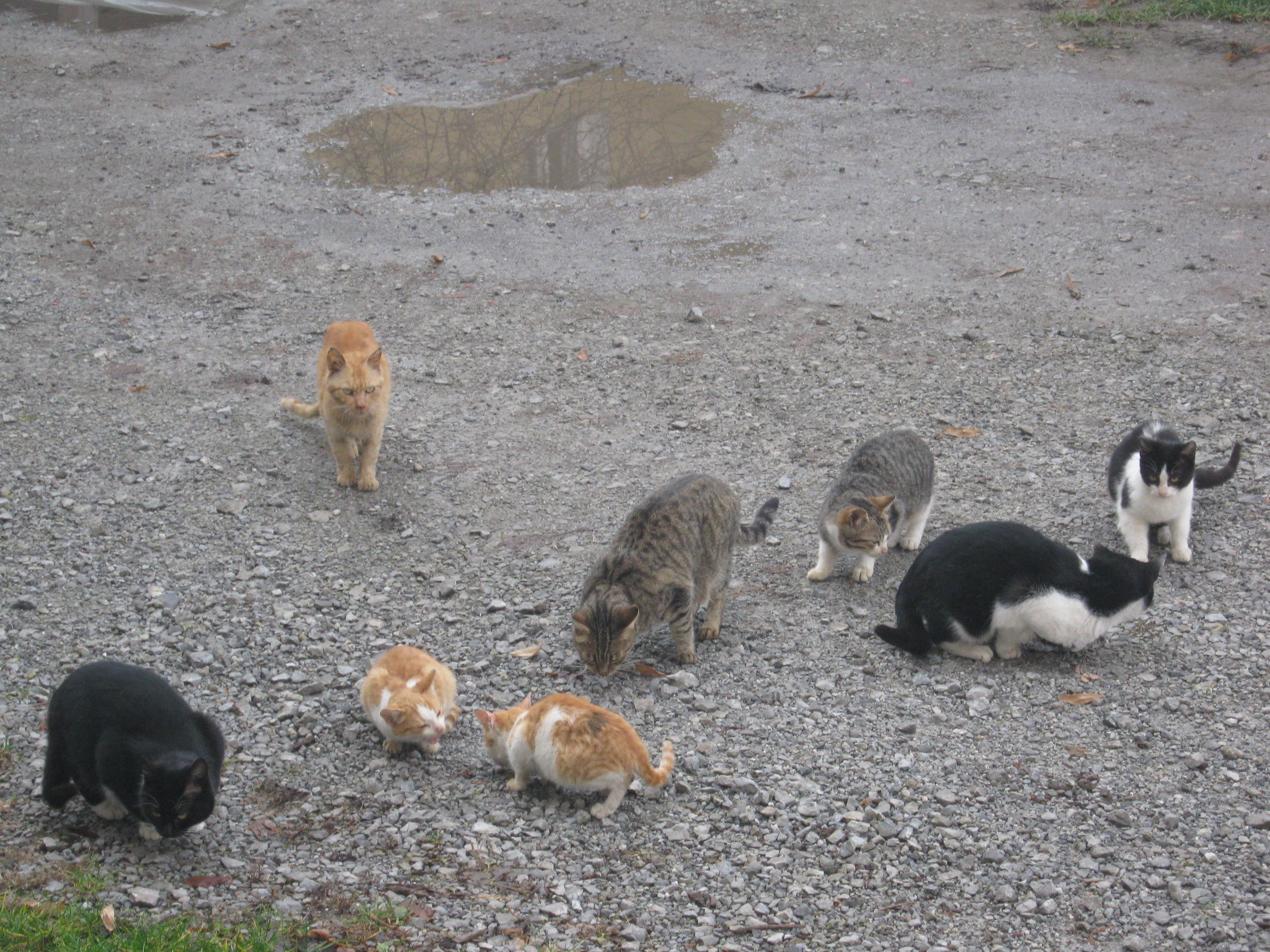It has been estimated that there are over 500 million cats in the world today. And according to the Humane Society of the United States (HSUS), there are over 70 million stray and feral cats in the U.S. (A stray cat is an abandoned or runaway cat while a feral cat is one that has returned to living in the wild, or is born wild.)
~ A feral cat "admiring" the ducks at Disneyland.
About a week ago, Vice.com published a report on a colony of about a hundred feral cats at Disneyland, click here. Apparently, generations of cats have been living there since 1955! But these are very lucky cats as Disney has been quietly taking good care of them by providing food and shelter, vet care, spaying and neutering, vaccinations, flea treatments, and tagging. Sadly, outside of Disneyland, reality is very different for feral cats.
 ~ Feral cats fending for themselves.
~ Feral cats fending for themselves.
According to the ASPCA, a feral cat that lives by itself – and has not been assisted by humans – has an average life expectancy of under two years. However, feral cats in a colony that is aided by humans may live for much longer. Regardless, the lives of feral cats are very harsh (even cats in human-assisted colonies sometimes migrate or are driven from the controlled areas). Some of the conditions that feral cats may face include: dehydration and starvation; drinking dirty water and eating rotten food; braving freezing temperatures in the winter; getting poisoned from rodenticides, insecticides, and herbicides; contracting parasites and diseases like rabies; being tortured and killed by cruel humans, stray dogs, and urban coyotes; and getting hit by cars to die slowly on the roadside.
~ Indoor cats live better lives than outdoor cats.
Also, feral cats may carry diseases that can hurt humans and pets. Feline leukemia virus, immunodeficiency virus, rabies, kidney disease, and distemper can spread from a stray cat to a domesticated cat through bodily fluids or bites, making the latter very sick with the possibility of death. And bacterial, parasitic, viral, and fungal infections can spread from your infected cat to you and your family members. Vaccination and keeping your cat indoors are the best defence.
But outdoor cats' impact on indigenous wildlife is far more devastating. Cats may be killing up to 3.7 billion birds each year in the U.S. alone (ground nesting birds are the most vulnerable). They also may be killing as many as 21 billion small mammals each year in the United States, and that is on top of the millions of native reptiles and amphibians. Cats are believed to be responsible for the extinction of 33 species of wildlife worldwide. The bottom line is, the house cat is a foreign (invasive) species to North America and indigenous wildlife simply did not have time to adapt to its presence. Click here.
~ T.N.R. (trap-neuter-return) reduces population through attrition.
It is imperative that people keep their cats indoors as well as having them spayed and neutered. For feral cats, the strategy of trapping and euthanizing them has proven to be a failure. Community cooperation is vital in this regard and euthanasia often drives away local support. However, trap-neuter-return (T.N.R.) programs seem to be working. While this does not solve the wildlife problem in the short run, it is a viable long-term solution. Often, kittens of feral cats are taken to be put up for adoption as they are capable of being tamed, unlike their parents.
As the holidays approach, FrogBook.com implores its readers to refrain from giving out ANY animal as a present. Some people, especially children, are not good at taking care of animals. After the initial novelty has worn off, owners may grow tired of their pets and become negligent or even abusive; and as a result, the animals may run away or become abandoned, click here. Deciding on whether to keep a pet requires a tremendous amount of consideration and planning. And when a decision is finally made to have a dog or cat as an addition to your family, you will find that adoption is the best policy socially, ethically, and financially.
~ Stray dogs are also a very big problem.
While stray dogs have a lesser impact on wildlife, their numbers are just as mind-boggling. According to the World Health Organization (WHO), there may be as many as 200 million stray dogs in the world. And their impact on public health and the environment is quite significant, click here. Therefore, spaying and neutering as well as adoption are the best tactics in regard to your dog. Also, always keep your dog indoors or confined to a secure yard; and make sure to leash your dog when you go out for walks (unleashed dogs running into traffic and attacking humans and other dogs – as well as park animals – are common occurrences, click here).
~ Pure-bred dogs and cats are less healthy than mix-breeds.
People love pure-bred cats such as the Persian and Siamese breeds. And poodles and Labradors are very popular dogs. Pure-breeds are a form of status symbol in society. But the healthiest cats and dogs are mix-breeds (sometimes called mongrels or mutts for dogs); they have a stronger and more diverse genetic make-up for longer lives and fewer diseases. This means less vet bills for you. In addition, they are less likely to be in physical and mental pain as compared to the pure-breeds, which are the result of inbreeding and arbitrary and unreasonable selective breeding. Click here.
~ Avoid pet dealers and puppy mills as well as kitty mills.
For related articles in the Frog Blog:
- Shark Fin Sales Drop Up To 70% In China Click here.
- Asian Carps: Barbarians At The Gate! Click here.
- "Let The Panda Die Out": Wildlife Expert Click here.
- Escaped Python Kills Two Boys Click here.
- Film: Blackfish Exposes SeaWorld Cruelty Click here.
- Bluefin Tuna Sold For $1.7 Million! Click here.
- Justin Bieber Attacked Over His Monkey Click here.
- Moron Lets Infant Play With A Gorilla Click here.
- Prince William Attacks Rhino Poachers Click here.
- Exotic Animals To Return To Zanesville! Click here.
- Bluefin Tuna Sold For A Record $736,000 Click here.
- 50 Exotic/Rare Animals Killed In Ohio Click here.











